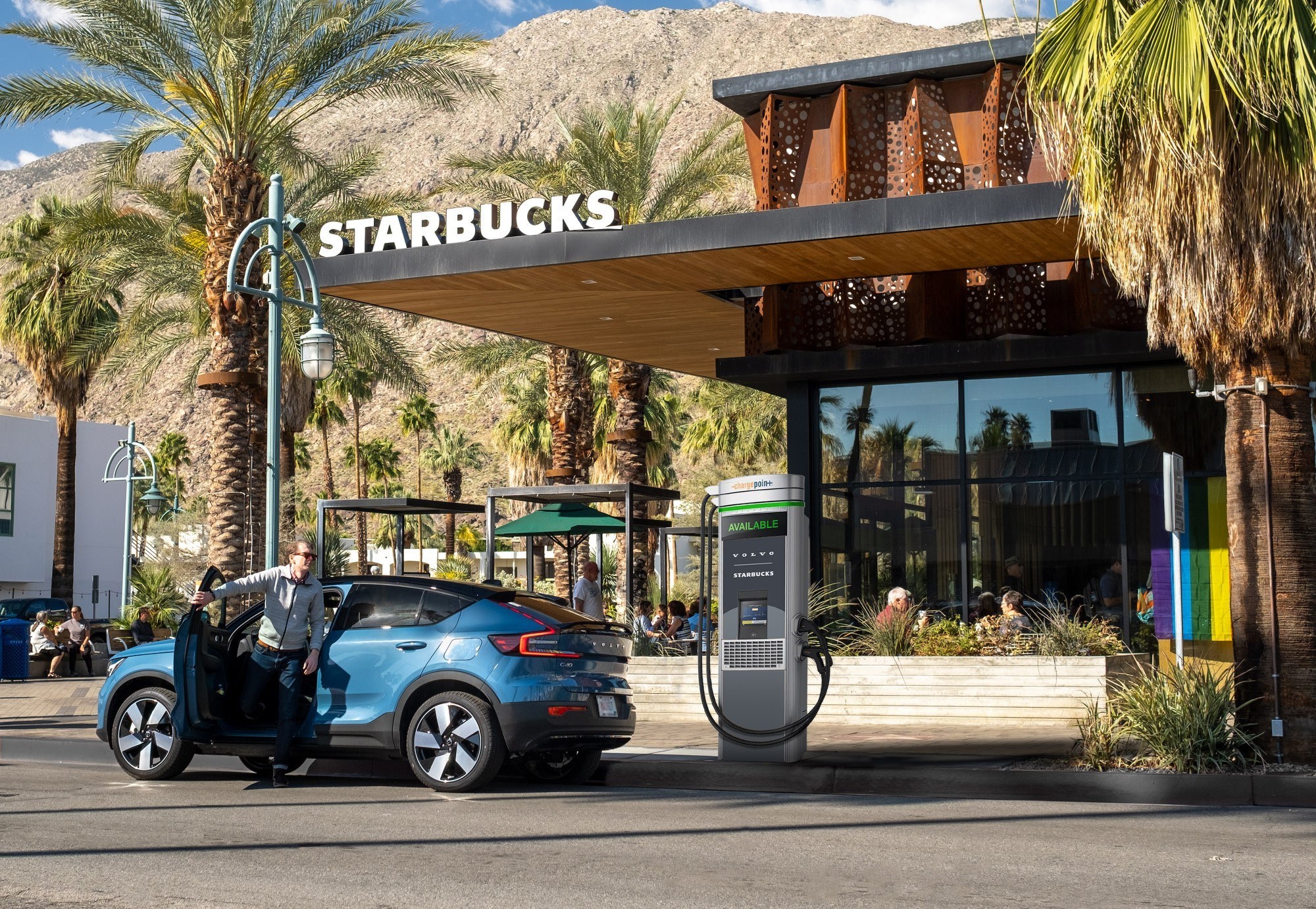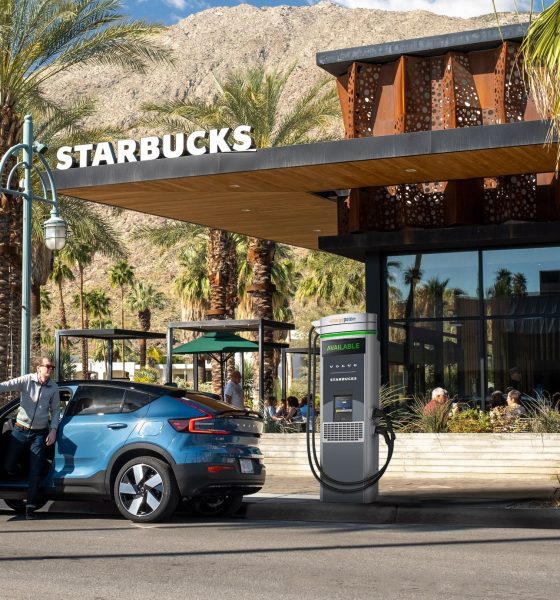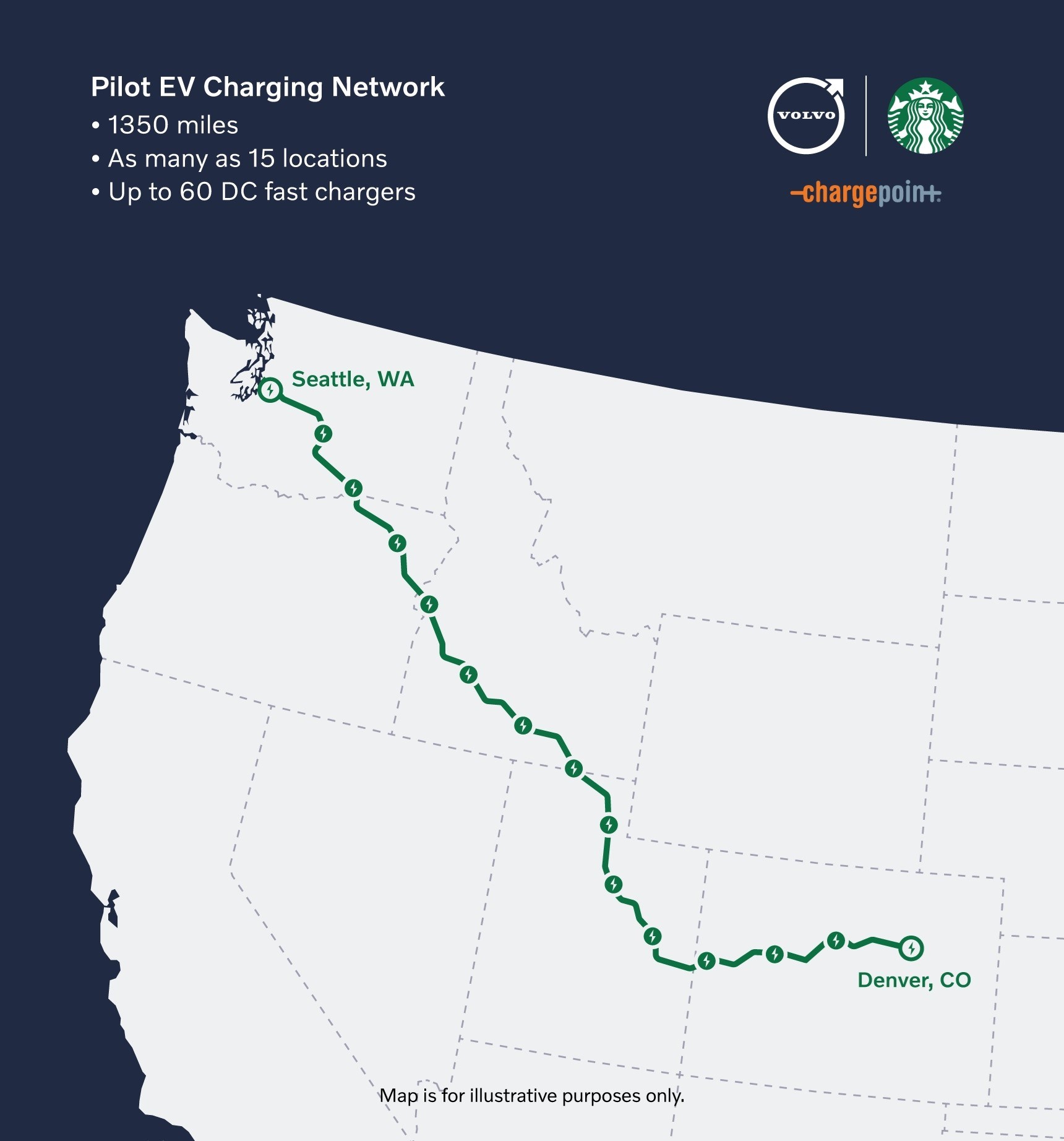

News
Volvo teams with Starbucks to install EV charging network at U.S. locations
Volvo Car USA and Starbucks are partnering to establish the first public electric vehicle charging network at numerous U.S. locations beginning this Summer. The charging stations, powered by ChargePoint, will be installed at up to 15 stores along a 1,350-miles corridor from Seattle to Denver.
At the 15 locations, up to 60 Volvo-branded DC fast chargers supplied by ChargePoint will be placed at various Starbucks locations along a 1,350-mile route from company headquarters in Seattle to Denver, Colorado. The charging locations will be separated by about 100 miles, a perfect distance for even the lowest-range EVs on the market.
Starbucks Static Map (Credit: Volvo)
The DC fast chargers will give customers the opportunity to give their car, and themselves, additional charge with electrodes and caffeine. Expanding charging network infrastructure to retail locations, especially quick stops like a coffee shop, help EV drivers obtain even a few additional miles of range. ChargePoint’s DC fast chargers would supply Volvo’s C40 Recharge from 20 percent state of charge to 90 percent in just 40 minutes. That’s plenty of time to order a coffee and enjoy it, returning to your near fully-charged car.
Any electric vehicle will be able to utilize the ChargePoint DC fast chargers, but only Volvo’s vehicles will charge for free, a press release from Volvo said.
Volvo Recharge models with Google embedded can use the ChargePoint app to locate and access the Starbucks-located charging stations along the route. The ChargePoint app is integrated into Volvo Recharge models’ in-dash system.
Installations of the new EV chargers are expected to be finished by the end of 2022. The locations are positioned for stress-free travel between the Rocky Mountains and Pacific Northwest, in a string of familiar, reliable, clean, and safe places to recharge themselves and their battery-powered vehicles, Volvo said.
“Volvo Cars wants to give people the freedom to move and lower their impact on the environment,” Anders Gustafsson, Sr. Vice President Americas and President and CEO for Volvo USA, said. “Working with Starbucks we can do that by giving them enjoyable places to relax while their cars recharge.”
While Volvo plans to be all-electric by 2030, Starbucks said in a press release that it also plans to lead the retail industry in decarbonization solutions, including EV charging stations and onsite solar at stores. Starbucks has plans to expand its solar pilot program to 55 additional locations this year.
“We are thrilled to partner with Volvo Cars to test how we can charge our customers’ electric vehicles at Starbucks stores,” Michael Kobori Chief Sustainability Officer at Starbucks said. “Imagine a future where Starbucks helps our customers to connect—-more sustainably.”
ChargePoint has done incredible work expanding its EV network across Europe. The company also said it was excited regarding the new Volvo-Starbucks partnership. “ChargePoint is enabling accessible EV charging opportunities anywhere drivers need it,” Pasquale Romano, President and CEO of ChargePoint said. “We’re excited to support Volvo Cars’ road to electrification, and help provide a premium driving experience for its customers to plan charging stops around their favorite Starbucks locations in select west coast destinations.”

News
Tesla FSD fleet is nearing 7 billion total miles, including 2.5 billion city miles
As can be seen on Tesla’s official FSD webpage, vehicles equipped with the system have now navigated over 6.99 billion miles.

Tesla’s Full Self-Driving (Supervised) fleet is closing in on almost 7 billion total miles driven, as per data posted by the company on its official FSD webpage.
These figures hint at the massive scale of data fueling Tesla’s rapid FSD improvements, which have been quite notable as of late.
FSD mileage milestones
As can be seen on Tesla’s official FSD webpage, vehicles equipped with the system have now navigated over 6.99 billion miles. Tesla owner and avid FSD tester Whole Mars Catalog also shared a screenshot indicating that from the nearly 7 billion miles traveled by the FSD fleet, more than 2.5 billion miles were driven inside cities.
City miles are particularly valuable for complex urban scenarios like unprotected turns, pedestrian interactions, and traffic lights. This is also the difference-maker for FSD, as only complex solutions, such as Waymo’s self-driving taxis, operate similarly on inner-city streets. And even then, incidents such as the San Francisco blackouts have proven challenging for sensor-rich vehicles like Waymos.
Tesla’s data edge
Tesla has a number of advantages in the autonomous vehicle sector, one of which is the size of its fleet and the number of vehicles training FSD on real-world roads. Tesla’s nearly 7 billion FSD miles then allow the company to roll out updates that make its vehicles behave like they are being driven by experienced drivers, even if they are operating on their own.
So notable are Tesla’s improvements to FSD that NVIDIA Director of Robotics Jim Fan, after experiencing FSD v14, noted that the system is the first AI that passes what he described as a “Physical Turing Test.”
“Despite knowing exactly how robot learning works, I still find it magical watching the steering wheel turn by itself. First it feels surreal, next it becomes routine. Then, like the smartphone, taking it away actively hurts. This is how humanity gets rewired and glued to god-like technologies,” Fan wrote in a post on X.
News
Tesla starts showing how FSD will change lives in Europe
Local officials tested the system on narrow country roads and were impressed by FSD’s smooth, human-like driving, with some calling the service a game-changer for everyday life in areas that are far from urban centers.

Tesla has launched Europe’s first public shuttle service using Full Self-Driving (Supervised) in the rural Eifelkreis Bitburg-Prüm region of Germany, demonstrating how the technology can restore independence and mobility for people who struggle with limited transport options.
Local officials tested the system on narrow country roads and were impressed by FSD’s smooth, human-like driving, with some calling the service a game-changer for everyday life in areas that are far from urban centers.
Officials see real impact on rural residents
Arzfeld Mayor Johannes Kuhl and District Administrator Andreas Kruppert personally tested the Tesla shuttle service. This allowed them to see just how well FSD navigated winding lanes and rural roads confidently. Kruppert said, “Autonomous driving sounds like science fiction to many, but we simply see here that it works totally well in rural regions too.” Kuhl, for his part, also noted that FSD “feels like a very experienced driver.”
The pilot complements the area’s “Citizen Bus” program, which provides on-demand rides for elderly residents who can no longer drive themselves. Tesla Europe shared a video of a demonstration of the service, highlighting how FSD gives people their freedom back, even in places where public transport is not as prevalent.
What the Ministry for Economic Affairs and Transport says
Rhineland-Palatinate’s Minister Daniela Schmitt supported the project, praising the collaboration that made this “first of its kind in Europe” possible. As per the ministry, the rural rollout for the service shows FSD’s potential beyond major cities, and it delivers tangible benefits like grocery runs, doctor visits, and social connections for isolated residents.
“Reliable and flexible mobility is especially vital in rural areas. With the launch of a shuttle service using self-driving vehicles (FSD supervised) by Tesla in the Eifelkreis Bitburg-Prüm, an innovative pilot project is now getting underway that complements local community bus services. It is the first project of its kind in Europe.
“The result is a real gain for rural mobility: greater accessibility, more flexibility and tangible benefits for everyday life. A strong signal for innovation, cooperation and future-oriented mobility beyond urban centers,” the ministry wrote in a LinkedIn post.
News
Tesla China quietly posts Robotaxi-related job listing
Tesla China is currently seeking a Low Voltage Electrical Engineer to work on circuit board design for the company’s autonomous vehicles.

Tesla has posted a new job listing in Shanghai explicitly tied to its Robotaxi program, fueling speculation that the company is preparing to launch its dedicated autonomous ride-hailing service in China.
As noted in the listing, Tesla China is currently seeking a Low Voltage Electrical Engineer to work on circuit board design for the company’s autonomous vehicles.
Robotaxi-specific role
The listing, which was shared on social media platform X by industry watcher @tslaming, suggested that Tesla China is looking to fill the role urgently. The job listing itself specifically mentions that the person hired for the role will be working on the Low Voltage Hardware team, which would design the circuit boards that would serve as the nervous system of the Robotaxi.
Key tasks for the role, as indicated in the job listing, include collaboration with PCB layout, firmware, mechanical, program management, and validation teams, among other responsibilities. The role is based in Shanghai.
China Robotaxi launch
China represents a massive potential market for robotaxis, with its dense urban centers and supportive policies in select cities. Tesla has limited permission to roll out FSD in the country, though despite this, its vehicles have been hailed as among the best in the market when it comes to autonomous features. So far, at least, it appears that China supports Tesla’s FSD and Robotaxi rollout.
This was hinted at in November, when Tesla brought the Cybercab to the 8th China International Import Expo (CIIE) in Shanghai, marking the first time that the autonomous two-seater was brought to the Asia-Pacific region. The vehicle, despite not having a release date in China, received a significant amount of interest among the event’s attendees.








